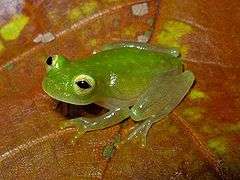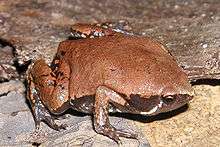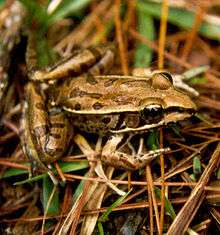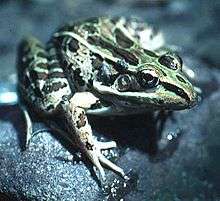List of amphibians of Guatemala
This is a list of amphibians found in Guatemala. There are 158 amphibian species recorded in Guatemala, which are grouped in 3 orders: Caecilians (Gymnophiona), Salamanders (Caudata) and Frogs and Toads (Anura). The IUCN considers that 33 of these species are critically endangered, 27 endangered, 11 near threatened and 21 vulnerable. This list is largely derived from the database listing of AmphibiaWeb[1] and Campbell's checklist.[2]
| Table of contents |
|---|
|
Frogs and Toads: Rhinophrynidae . Craugastoridae . Leptodactylidae . Eleutherodactylidae . Bufonidae . Hylidae . Centrolenidae . Microhylidae . Ranidae . |
Caecilians (Gymnophiona)
Caeciliidae
Caeciliidae, or common caecilians, is a family of caecilians that are native to South and Central America, equatorial Africa and India. Like other caecilians, they superficially resemble worms or snakes. Although they are the most diverse of the caecilian families, the caeciliids do have a number of features in common that distinguish them from other caecilians. In particular, their skulls have relatively few bones, with those that are present being fused to form a solid ram to aid in burrowing through the soil. The mouth is recessed beneath the snout, and there is no tail. There are more than 100 caeciliids worldwide, 2 of which occur in Guatemala.
Order: Gymnophiona. Family: Caeciliidae
- Dermophis mexicanus (Duméril and Bibron, 1841)
- Gymnopis syntrema (Cope, 1866)
Salamanders (Caudata)
Plethodontidae
Order: Caudata. Family: Plethodontidae
The Plethodontidae, or Lungless salamanders, are a family of salamanders. Most species are native to the western hemisphere, from British Columbia to Brazil, although a few species are found in Sardinia, Europe south of the Alps, and South Korea. A number of features distinguish the Plethodontids from other salamanders. Most significantly, they lack lungs, conducting respiration through their skin, and the tissues lining their mouths. Another distinctive feature is the presence of a vertical slit between the nostril and upper lip, known as the "naso-labial groove". The groove is lined with glands, and enhances the salamander's chemoreception. Due to their modest size and low metabolism, they are able to feed on prey such as collembola, which are usually too small for other terrestrial vertebrates. This gives them access to a whole ecological niche with minimal competition from other groups. They are by far the largest group of salamanders. There are about 380 species worldwide, of which 41 occur in Guatemala.
- Oak Forest Salamander -- Bolitoglossa cuchumatana (Stuart, 1943) [E]
- Doflein's Salamander -- Bolitoglossa dofleini (Werner, 1903)
- Dunn's Climbing Salamander -- Bolitoglossa dunni (Schmidt, 1933) [EN]
- Engelhardt's Climbing Salamander -- Bolitoglossa engelhardti (Schmidt, 1936) [EN]
- Yellow-legged Climbing Salamander -- Bolitoglossa flavimembris (Schmidt, 1936) [EN]
- Yellow-belly Climbing Salamander -- Bolitoglossa flaviventris (Schmidt, 1936)
- Franklin's Climbing Salamander -- Bolitoglossa franklini (Schmidt, 1936) [EN]
- Hartweg's Climbing Salamander -- Bolitoglossa hartwegi Wake and Brame, 1969
- Coban Climbing Salamander -- Bolitoglossa helmrichi (Schmidt, 1936) [E]
- Jackson's Climbing Salamander -- Bolitoglossa jacksoni Elias, 1984 [E]
- Lincoln's Climbing Salamander -- Bolitoglossa lincolni (Stuart, 1943)
- Meliana Climbing Salamander -- Bolitoglossa meliana Wake and Lynch, 1982 [E, EN]
- Mexican Climbing Salamander -- Bolitoglossa mexicana Duméril, Bibron, and Duméril, 1854
- Cope's Climbing Salamander -- Bolitoglossa morio (Cope, 1869) [E]
- Muller's Climbing Salamander -- Bolitoglossa mulleri (Brocchi, 1883) [VU]
- Southern Banana Salamander -- Bolitoglossa occidentalis Taylor, 1941
- O'donnell's Climbing Salamander -- Bolitoglossa odonnelli (Stuart, 1943) [EN]
- Bolitoglossa resplendens McCoy and Walker, 1966
- Long-nosed Climbing Salamander -- Bolitoglossa rostrata (Brocchi, 1883) [VU]
- Northern Banana Salamander -- Bolitoglossa rufescens (Cope, 1869)
- Salvin's Salamander -- Bolitoglossa salvinii (Gray, 1868) [EN]
- Stuart's Salamander -- Bolitoglossa stuarti Wake and Brame, 1969 [EN]
- Yucatan Salamander -- Bolitoglossa yucatana (Peters, 1882)
- Finca Chiblac Salamander -- Bradytriton silus Wake and Elias, 1983 [E, CR]
- Monzon's Hidden Salamander -- Cryptotriton monzoni (Campbell and Smith, 1998) [E, CR]
- Baja Verepaz Salamander -- Cryptotriton veraepacis (Lynch and Wake, 1978) [E, EN]
- Wake's Hidden Salamander -- Cryptotriton wakei (Campbell and Smith, 1998)
- Common Bromeliad Salamander -- Dendrotriton bromeliacius (Schmidt, 1936) [EN]
- Cuchumatanes Bromeliad Salamander -- Dendrotriton cuchumatanus (Lynch and Wake, 1975) [E, CR]
- Guatemalan Bromeliad Salamander -- Dendrotriton rabbi (Lynch and Wake, 1975) [EN]
- Cerro Pozo de Agua Moss Salamander -- Nototriton brodiei Campbell and Smith, 1998
- Stuart's Moss Salamander -- Nototriton stuarti Wake and Campbell, 2000 [E]
- Long-limbed Salamander -- Nyctanolis pernix Elias and Wake, 1983 [EN]
- White-crowned Worm Salamander -- Oedipina elongata (Schmidt, 1936)
- Chimaltenango Worm Salamander -- Oedipina ignea Stuart, 1952
- Narrow-footed Worm Salamander -- Oedipina stenopodia Brodie and Campbell, 1993 [E, EN]
- Taylor's worm Salamander -- Oedipina taylori Stuart, 1952
- Brown False Brook Salamander -- Pseudoeurycea brunnata Bumzahem and Smith, 1955 [CR]
- Jalpa False Brook Salamander -- Pseudoeurycea exspectata Stuart, 1954 [E, CR]
- Goebel's False Brook Salamander -- Pseudoeurycea goebeli (Schmidt, 1936) [EN]
- Royal False Brook Salamander -- Pseudoeurycea rex (Dunn, 1921)
Frogs and Toads (Anura)
Rhinophrynidae
Order: Anura. Family: Rhinophrynidae
Rhinophrynida is a monotypical family which contains one single species (Rhinophrynus dorsalis), distributed from southern Texas through Mexico, Guatemala, Honduras, El Salvador to Nicaragua and Costa Rica. Rhinophrynus dorsalis, commonly known as the Mexican Burrowing Toad, grows to 8 cm (3.1 in) in length, and usually has red spots on its bloated body with a red stripe along the center of its back. It has short legs, and a small, pointed head. Its feet have horny, shovel-like appendages which, along with the short, powerful legs, aid it in digging. Its eyes are relatively small, and the tympanum is not visible.
- Mexican Burrowing Toad -- Rhinophrynus dorsalis Duméril and Bibron, 1841
Craugastoridae
Order: Anura. Family: Craugastoridae

- Craugastor adamastus Campbell 1994 [E]
- Craugastor alfredi (Boulenger, 1898) [VU]
- Craugastor amniscola Campbell and Savage, 2000
- Craugastor aphanus Campbell 1994 [E, VU]
- Craugastor bocourti (Brocchi, 1877) [E, VU]
- Craugastor brocchi (Boulenger, 1882) [VU]
- Craugastor campbelli[3] (Smith, 2005) [E]
- Craugastor chac Savage, 1987
- Craugastor charadra Campbell and Savage, 2000 [EN]
- Craugastor daryi Ford and Savage, 1884 [E, EN]
- Craugastor greggi Bumzahem, 1955 [CR]
- Craugastor inachus Campbell and Savage, 2000 [E, EN]
- Craugastor laticeps (A. Duméril, 1853)
- Craugastor lineatus (Brocchi, 1879) [CR]
- Craugastor loki[4] (Shannon & Werler, 1955)
- Craugastor matudai Taylor [VU]
- Craugastor myllomyllon (Savage, 2000) (E)
- Craugastor nefrens (Smith, 2005)
- Craugastor palenque Campbell and Savage, 2000
- Craugastor psephosypharus Campbell, Savage, and Meyer, 1994 [VU]
- Craugastor pygmaeus Taylor, 1936
- Craugastor rhodopis (Cope, 1867)
- Craugastor rivulus Campbell and Savage, 2000
- Craugastor rostralis (Werner, 1896)
- Craugastor rupinius Campbell and Savage, 2000
- Craugastor sabrinus Campbell and Savage, 2000
- Craugastor sandersoni Schmidt, 1941
- Craugastor stuarti Lynch, 1967
- Craugastor trachydermus Campbell 1994
- Craugastor xucanebi Stuart, 1941
Leptodactylidae
Order: Anura. Family: Leptodactylidae
Leptodactylidae is a large and diverse family of frogs that are widely distributed throughout Mexico, Central America, the Caribbean, and South America. The family includes terrestrial, burrowing, aquatic, and arboreal members, inhabiting a wide range of different habitats. There are roughly 50 genera, with approximately 1100 leptodactylid species, 4 of which occur in Guatemala.
- Tungara frog -- Engystomops pustulosus (Cope, 1864) [5]
- Mexican White-lipped Frog -- Leptodactylus fragilis (Brocchi, 1878)
- Leptodactylus labialis (Cope, 1877)[6]
- Leptodactylus melanonotus (Hallowell, 1860)
Eleutherodactylidae
Order: Anura. Family: Eleutherodactylidae
Eleutherodactylidae is a large family of frogs that are distributed in the neotropics, from the south of Texas, through Central America to the north of South America. 3 species occur in Guatemala.
- Eleutherodactylus leprus Cope, 1879[7] [VU]
- Eleutherodactylus pipilans Taylor, 1940[8]
- Eleutherodactylus rubrimaculatus Taylor and Smith, 1945[9] [VU]
Bufonidae
Order: Anura. Family: Bufonidae
True toads (Bufonidae) are a family in the order of Anura (frogs and toads). They are the only family of anurans all members of which are known as "toads". True toads are widespread and occur natively on every continent except Australia and Antarctica, inhabiting a variety of environments, from arid areas to rainforest. Most lay eggs in paired strings that hatch into tadpoles. True toads are toothless and generally warty in appearance. They have a pair of parotoid glands on the back of their heads. These glands contain an alkaloid poison which the toads excrete when stressed. Some toads, like the cane toad Bufo marinus, are more toxic than others. The bufonids now comprise more than 35 genera, Bufo being the most widespread and well known. 12 species occur in Guatemala.
- Bocourt's Toad -- Bufo bocourti Brocchi, 1877
- Campbell's Forest Toad -- Bufo campbelli Mendelson, 1994
- Dwarf Toad -- Bufo canaliferus Cope, 1877
- Southern Round-gland Toad -- Bufo coccifer Cope, 1866
- Jalapa Toad -- Bufo ibarrai Stuart, 1954 [EN]
- Yellow Toad -- Bufo luetkenii Boulenger, 1891
- Large-crested Toad -- Bufo macrocristatus Firschein and Smith, 1957 [VU]
- Cane Toad -- Bufo marinus (Linnaeus, 1758)
- Volcan Tacana Toad -- Bufo tacanensis P. Smith, 1952 [EN]
- Bufo tutelarius Mendelson, 1997 [EN]
- Gulf Coast Toad -- Bufo valliceps Wiegmann, 1833
- Bufo wilsoni Baylor and Stuart, 1961[10]
Hylidae
Hylidae is a wide-ranging family of frogs commonly referred to as "tree frogs and their allies". However, the hylids include a diversity of frog species, many of which do not live in trees, but are terrestrial or semi-aquatic. Most hylids show adaptations suitable for an arboreal lifestyle, including forward-facing eyes providing binocular vision, and adhesive pads on the fingers and toes. In the non-arboreal species, these features may be greatly reduced, or absent. The Cyclorana species are burrowing frogs, that spend much of their lives underground. Hylids mostly feed on insects and other invertebrates, but some larger species can feed on small vertebrates. Hylids lay their eggs in a range of different locations, depending on species. Many use ponds, or puddles that collect in the holes of their trees, while others use bromeliads or other water-holding plants. Other species lay their eggs on the leaves of vegetation overhanging water, allowing the tadpoles to drop into the pond when they hatch. A few species use fast-flowing streams, attaching the eggs firmly to the substrate. The tadpoles of these species have suckers enabling them to hold onto rocks after they hatch. Another unusual adaptation is found in some South American hylids, which brood the eggs on the back of the female. Hylids are distributed in the Americas, Eurasia, extreme north of Africa, Australia, New Guinea and Japan. 38 species occur in Guatemala.
- Red-eyed Tree Frog -- Agalychnis callidryas (Cope, 1862)
- Black-eyed Tree Frog -- Agalychnis moreletii (Duméril, 1853) [CR]
- Bromeliad treefrog -- Bromeliohyla bromeliacia Schmidt, 1933[11] [EN]
- Hourglass Treefrog -- Dendropsophus ebraccatus Cope, 1874[12]
- Yellow Treefrog -- Dendropsophus microcephalus Cope, 1886[13]
- Mertens' Yellow Treefrog -- Dendropsophus robertmertensi Taylor, 1937[14]
- Schmidt's Mountain Brook Frog -- Duellmanohyla schmidtorum (Stuart, 1954) [VU]
- Copan Brook Frog -- Duellmanohyla soralia (Wilson and MCCranie, 1985) [CR]
- Guatemala treefrog -- Ecnomiohyla minera Wilson, McCranie, and Williams, 1985[15] [E, EN]
- Copan treefrog -- Ecnomiohyla salvaje Wilson, McCranie, and Williams, 1985 [CR]
- Bocourt's Tree Frog -- Hyla bocourti Mocquard, 1899 [E, CR]
- Hyla perkinsi Campbell and Brodie, 1992 [E, CR]
- Walker's Tree Frog -- Hyla walkeri Stuart, 1954 [VU]
- Plectrohyla acanthodes Duellman and Campbell, 1992 [CR]
- Plectrohyla avia Stuart, 1953 [CR]
- Ptychohyla dendrophasma Campbell, Smith, and Acevedo, 2000[16] [CR]
- Plectrohyla glandulosa (Boulenger, 1883) [EN]
- Plectrohyla guatemalensis Brocchi, 1877 [CR]
- Plectrohyla hartwegi Duellman, 1968 [CR]
- Plectrohyla ixil Stuart, 1942 [CR]
- Plectrohyla matudai Hartweg, 1941 [VU]
- Plectrohyla pokomchi Duellman and Campbell, 1984 [E, CR]
- Plectrohyla quecchi Stuart, 1942 [E, CR]
- Plectrohyla sagorum Hartweg, 1941 [EN]
- Plectrohyla tecunumani Duellman and Campbell, 1984 [E, CR]
- Plectrohyla teuchestes Duellman and Campbell, 1992 [E, CR]
- Ptychohyla euthysanota (Kellogg, 1928)
- Ptychohyla macrotympanum (Tanner, 1957) [CR]
- Ptychohyla panchoi Duellman and Campbell, 1982 [E, EN]
- Ptychohyla hypomykter McCranie and Wilson, 1993 [CR]
- Ptychohyla sanctaecrucis Campbell and Smith, 1992 [E, CR]
- Scinax staufferi (Cope, 1865)
- Smilisca baudinii (Duméril and Bibron, 1841)
- Smilisca cyanosticta (Smith, 1953)
- Mahogany Treefrog -- Tlalocohyla loquax Gaige and Stuart, 1934
- Painted Treefrog -- Tlalocohyla picta (Günther, 1901)
- Veined Treefrog -- Trachycephalus venulosus Laurenti, 1768 [17]
- Triprion petasatus (Cope, 1865)
Centrolenidae
Order: Anura. Family: Centrolenidae
Glass frogs (Centrolenidae) are a family of generally small frogs, ranging from 3 to 7.5 centimetres (1.2 to 3.0 in) in length, distributed from southern Mexico, through Central America and South America. While the general background coloration of most glass frogs is primarily lime green, the abdominal skin of some members of this family is transparent. The internal viscera, including the heart, liver, and gastrointestinal tract are visible through this translucent skin, hence the common name. There is one species in Guatemala.
- Fleischmann's glass frog -- Hyalinobatrachium fleischmanni (Boettger, 1893)
Microhylidae
Order: Anura. Family: Microhylidae
Microhylidae is a geographically widespread family of frogs. Microhylids are mostly small frogs. Many species are below 1.5 centimetres (0.59 in) in length, although some species are as large as 9 centimetres (3.5 in). They can be arboreal or terrestrial, and some will even habit close to water. The ground dwellers are often found under leaf litter within forests, occasionally venturing out at night to hunt. There are two main shapes for the microhylids, one with wide bodies and narrow mouths, and the other with normal frog proportions. Those with narrow mouths generally eat termites and ants, and the others have diets typical of most frogs. The species of the genus Breviceps are burrowing frogs found in the arid regions of Africa. Some of their species will even lay their eggs under ground. Frogs from Microhylidae occur throughout the tropical and warm temperate regions of the Americas, Africa, eastern India, Sri Lanka, south-east Asia, through New Guinea and Australia. There are nine subfamilies, 68 genera, and 495 species worldwide, 5 of which occur in Guatemala.
- Gastrophryne elegans (Boulenger, 1882)
- Gastrophryne usta (Cope, 1866)
- Hypopachus barberi Schmidt, 1939 [VU]
- Hypophachus championi Stuart, 1940
- Hypopachus variolosus (cope, 1866)
Ranidae
The true frogs, family Ranidae, have the widest distribution of any frog family. They are abundant throughout most of the world, occurring on all continents except Antarctica. Typically, true frogs are smooth, moist-skinned frogs, with large, powerful legs and extensively webbed feet. True frogs vary greatly in size, ranging from small—such as the Wood Frog (Rana sylvatica)—to the largest frog in the world, the Goliath frog (Conraua goliath). Many of the true frogs are aquatic or live close to water. Most species lay their eggs in the water and go through a tadpole stage. However, as with most families of frogs, there is large variation of habitat within the family. Those of the genus Tomopterna are burrowing frogs native to Africa and exhibit most of the characteristics common to burrowing frogs around the world. There are also arboreal species of true frogs, and the family includes some of the very few amphibians that can live in brackish water. There are 6 species in Guatemala.
- Rana berlandieri Baird, 1854
- Rana forreri Boulenger, 1883
- Rana juliani Hillis and de Sá, 1988
- Rana macroglossa Brocchi, 1877 [VU]
- Rana maculata Brocchi, 1877
- Rana vaillanti Brocchi, 1877
See also
Notes
- ↑ AmphibiaWeb 2012
- ↑ Campbell 2007
- ↑ Not included in Campell's Checklist.
- ↑ Not included in Campell's Checklist.
- ↑ This species is included in Campbell's Checklist as Physalaemus pustulosus
- ↑ This species is included in Campbell's checklist as Leptodactylus labialis , but is considered a synonym of Leptodactylus fragilis (Brocchi, 1878) by other authorities.
- ↑ The species is included in Campbell's Checklist as "Syrrhophus leprus Cope, 1879"
- ↑ The species is included in Campbell's Checklist as "Syrrhophus pipilans Taylor, 1940"
- ↑ The species is included in Campbell's Checklist as "Syrrhophus rubrimaculatus Taylor & Smith, 1945"
- ↑ Included in Campbell's checklist, but not in Amphibia Web's database. Often considered a subspecies (I. v. wilsoni) of Incilius valliceps (Bufo valliceps). See: Incilius valliceps. The IUCN Red List of Threatened Species.
- ↑ Included in Campbell's Checklist as Hyla bromeliacea Schmidt, 1933
- ↑ Included in Campbell's Checklist as Hyla ebraccata Cope, 1874
- ↑ included as Hyla microcephala Cope, 1886 in AmphibiaWeb 2012
- ↑ included as Hyla robertmertensi in AmphibiaWeb 2012
- ↑ included as Hyla minera in AmphibiaWeb 2012
- ↑ Included in Campbell's Checklist as Hyla dendrophasma Campbell, Smith, and Acevedo, 2000
- ↑ Included in Campbell's Checklist as Phrynohyas venulosa
References
- AmphibiaWeb. Information on amphibian biology and conservation. (2012). "List of Amphibians in Guatemala (database query web application)". Berkeley, California: AmphibiaWeb. Retrieved 2012-04-15.
- Campbell, Jonathan A. (24 September 2007). "Reptiles and amphibians of Guatemala - Checklist". University of Texas at Arlington, Department of Biology. Retrieved 2012-03-10.




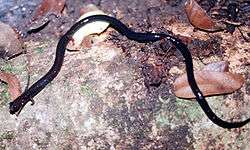
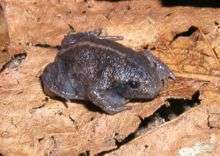
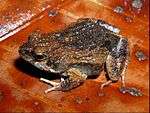



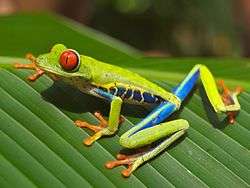
.jpg)

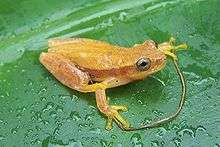
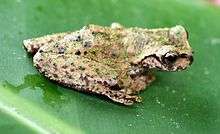
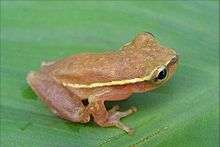
.jpg)
